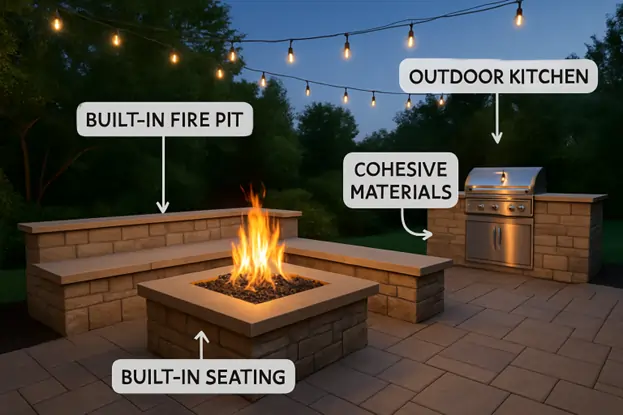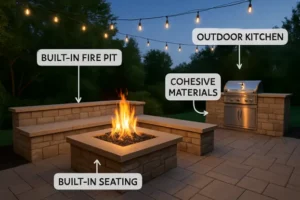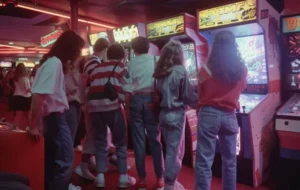Choosing the Right Fire Pit for Your Space
Incorporating a fire pit into your outdoor kitchen or patio instantly elevates the ambiance and usability of your backyard. Before choosing, explore the wide variety of custom backyard fire pits to find one that fits your unique design preferences and entertaining needs. Whether you opt for a rustic wood burner or a sleek gas unit, key considerations include fuel source, size, and material selection.
Your decision should account for the overall flow of your space and how the fire pit will complement your existing setup. Contemplate the number of guests you typically host and how you want to use the fire feature—whether for cooking, warmth, or simply as a visual focal point. Understanding your goals early ensures the fire pit becomes a centerpiece that enhances daily living and social experiences.
Strategic Placement for Safety and Functionality
Safety should be at the forefront of your planning process. To reduce the risk of fire hazards, always place the fire pit at least 10-15 feet away from structures, overhanging trees, or flammable materials. The surface beneath your fire pit should be level and made from non-combustible materials such as stone or concrete, offering a stable and secure foundation.
Consider the prevailing wind direction in your yard to prevent smoke from drifting into eating or lounging areas, quickly turning a pleasant gathering into an uncomfortable one. If possible, use natural wind blocks or plan landscaping accordingly to shield your seating area from smoke. This attention to placement and airflow can make a significant difference in both safety and enjoyment.
Harmonizing Materials and Design Elements
Select materials that coordinate with existing design elements to ensure your fire pit blends seamlessly with your outdoor kitchen and patio. For example, if your kitchen counters or dining area feature natural stone, carry that look into your fire pit’s structure for a unified appearance. Combining modern metals or classic brick with outdoor cabinetry and countertops can tie the whole area together and create a striking, cohesive look.
Incorporating Built-In Seating
Maximize space and comfort by adding built-in seating around your fire pit. Stone or brick benches look elegant and provide permanence and durability, effortlessly linking your fire pit to the rest of the patio architecture. Built-in seating invites social interaction by creating a dedicated gathering space that encourages visitors to relax and enjoy the warmth and ambiance.
Add weatherproof cushions and accent pillows to your built-in benches for a finishing touch. This adds a layer of coziness and introduces pops of color that can be swapped seasonally, keeping your outdoor area both functional and stylish throughout the year.
Adding Functional Features
Integrating features such as a cooking grate or rotisserie can take your fire pit’s versatility to the next level. These additions allow you to grill or prepare simple meals right at the fire, transforming the fire pit from a source of warmth and ambiance to a secondary cooking station. Always select heat-resistant, food-safe materials when choosing these upgrades, and integrate them seamlessly into the design to maintain safety and visual appeal.
Lighting and Ambiance
Thoughtful lighting transforms your fire pit area into a true backyard destination after sunset. Illuminate pathways with discreet, ground-level lights and consider installing ambient fixtures around the seating area for gentle, functional lighting. String lights, lanterns, or even recessed LED strips can establish a welcoming environment and enhance nighttime safety.
Layered lighting, such as a combination of overhead string lights paired with soft, in-ground fixtures, can create a cozy yet visually inviting ambiance.
Ensuring Proper Ventilation and Drainage
Proper ventilation is not optional for gas—powered fire pits—it’s critical for family safety and appliance longevity. Adequate airflow allows gas to dissipate and prevents dangerous build-up. For all fire pit types, be attentive to drainage by positioning your feature on a slight slope or installing a drainage system beneath it. This prevents rainwater accumulation, which can corrode interior components, compromise stonework, or lead to mildew and staining.
Addressing these infrastructure needs as part of the installation process prevents costly repairs and ensures your fire pit remains beautiful and functional year after year.
Compliance with Local Regulations
Before beginning installation, verify that your proposed fire pit setup aligns with local ordinances and building codes. Some municipalities restrict open flames or require gas hookups and permit permanent structures. Adhering to regulations ensures your project moves forward safely and prevents legal headaches. For more information, refer to your local city planning or fire department website for the most up-to-date guidelines.
Final Thoughts
Thoughtful planning and integrating a fire pit can turn your outdoor kitchen or patio into the ultimate gathering spot. By prioritizing safety, design harmony, functionality, and ambiance, you’ll create a backyard oasis that’s both beautiful and practical. Whether entertaining guests or unwinding after a long day, a well-designed fire pit adds warmth and elegance that can be enjoyed year-round.
Read more: How Music Programs Help Youth Develop Lifelong Skills – Croudmomentum.com
Employee Rights in the Modern Workplace – Croudmomentum.com
How Digital Mockups Help Designers Avoid Printing Mistakes – Croudmomentum.com








